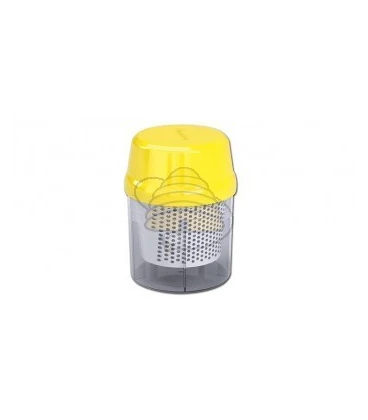Varroa EasyCheck
€ 27,99
The Easy Varroa tester is a simple way to count mites in a bee colony. The Easy Check can be used in two ways. The simplest and most bee-friendly method is with powdered sugar. The other way is with alcohol. How does the Varroa tester work and how do you calculate the number of mites in the bee colony? Shake about 200 bees into the lid of the tester. This is about 25 grams or half a cup. Then add powdered sugar and shake the cup upside down. Do this for about 1 to 2 minutes. Now turn the cup upright and keep shaking. The mites and powdered sugar will now fall to the bottom of the cup. The bees can go back into the hive and the powdered sugar can be shaken onto the lid of a honey bucket. By adding a thin layer of water you can easily count the mites. The other method uses alcohol; shake gently to prevent any alcohol from possibly leaking at the lid. The alcohol causes the mites to detach from the bees. They will fall through the mesh into the other compartment of the Varroa tester.
Read below to learn how to count the mites.
Customer ratings and reviews
Using either method, you can now easily count the mites. The quickest way to calculate the infestation rate in the colony is to divide the number of mites by the number of bees. So 10 mites from 200 bees: 10/200 = 0.05, i.e. 5% varroa mite infestation in the colony. From 5% onward, treatment is recommended. This calculation can also be used for the powdered sugar method. Scroll further down for a step-by-step guide and the calculation to determine the total number of varroa mites in the colony.
Varroa tester step-by-step
- Collect half a teacup of bees from a colony (25 grams); this is up to the red line on the varroa tester
- Add powdered sugar or alcohol
- Gently shake the bees
- Count the mites and divide this number by 200. This gives the percentage. Example: 10 mites / 200 bees = 0.05 = 5% varroa infestation. If your infestation is < 5% you do not need to treat. If the infestation is > 5% then treat the colony.
You can also now calculate the absolute number of mites in the colony. Do this by multiplying the estimated number of bees (A) by the number of mites (B) and dividing by the number of collected bees (200) (C). Example: number of mites in the colony = (A x B) / C. These represent approximately 20% of the bees in the colony. Multiply this number by 5 to determine the total number of mites in the colony.



